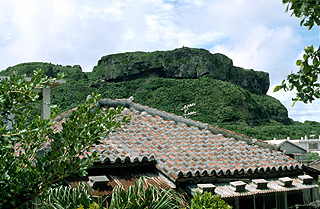… excerpted from Ryukyu Survey 1960 ~51~ By Naioichi Kokubu and Erika Kaneko
Yonaguni history is shrouded in complete mystery. Neither local traditions, nor outside sources provide reliable data for a reconstruction. Official written sources like the course gazette of the ‘Shuri ofu’ (AD 1707) offer no detailed information on the outlying Yayeyama islands, let alone isolated Yonaguni. The Yaeyama to Yurai ki and other locally compiled documents , originally in 7 volumes, was lost in the tidal wave of AD 1771; and it was subsequently reconstructed by order of the officials Miyara, Ishigaki and Ohama.
Sanai-Isoba. In local tradition the key figure is the female chieftain Sanai-Isoba.
Ikema and Arazato (1957:46) explain the name as a combination of the given female name Isoba with the place-name Sanai which in turn denotes the place of the gajumaru’ (ficus retusa, small-leafed banyan).
Sanai-Isoba is a female of superhuman stature and strength; she performed astonishing feats and taught the islanders agriculture and improved ways of life. She also established her four brothers as village heads of Donanbaru, Dateg, Dannu, and Tebaru. She is said to have gone abroad to Ishigaki and Iriomote, thereby initiating a cultural pattern, whereby the less advanced must learn from their superiors, viz. the Okinawans from the Chinese, the Miyakoans from the Okinawans and so forth, isolated, marginal Yonaguni was the lowest rung on the ladder.
Is Sanai-Isoba a historical person and if so when did she live? Every Yonaguni child can point out the field ‘where her house once stood’ and knows the location of her grave where under a large tree village trials were held until quite recently.
Sannai Isoba is worshiped in a ritual which takes place once a year. The high ranking Chimafuka family consider her their ancestor and until a generation ago reckoned from her its matrilineal descent.”
Note: Details from the story check out with written histories from the Shuri court in Ryukyu or Okinawa, and put Sanai-Isoba’s rule at 1500 AD, but the extent of her powers are seriously questioned, given that Yonaguni and Yaeyama were recorded to have been taken in an invasion by Nakayama Kanemaru who conquered Lord Oyake Akahachi in that year.


